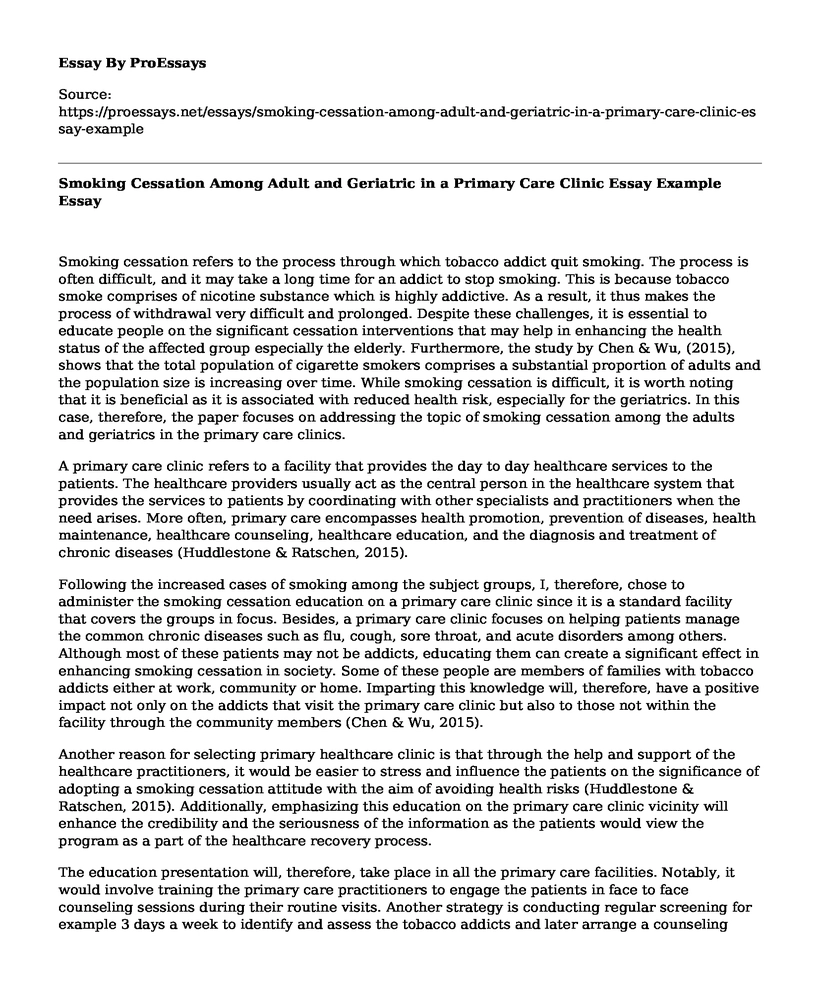Smoking cessation refers to the process through which tobacco addict quit smoking. The process is often difficult, and it may take a long time for an addict to stop smoking. This is because tobacco smoke comprises of nicotine substance which is highly addictive. As a result, it thus makes the process of withdrawal very difficult and prolonged. Despite these challenges, it is essential to educate people on the significant cessation interventions that may help in enhancing the health status of the affected group especially the elderly. Furthermore, the study by Chen & Wu, (2015), shows that the total population of cigarette smokers comprises a substantial proportion of adults and the population size is increasing over time. While smoking cessation is difficult, it is worth noting that it is beneficial as it is associated with reduced health risk, especially for the geriatrics. In this case, therefore, the paper focuses on addressing the topic of smoking cessation among the adults and geriatrics in the primary care clinics.
A primary care clinic refers to a facility that provides the day to day healthcare services to the patients. The healthcare providers usually act as the central person in the healthcare system that provides the services to patients by coordinating with other specialists and practitioners when the need arises. More often, primary care encompasses health promotion, prevention of diseases, health maintenance, healthcare counseling, healthcare education, and the diagnosis and treatment of chronic diseases (Huddlestone & Ratschen, 2015).
Following the increased cases of smoking among the subject groups, I, therefore, chose to administer the smoking cessation education on a primary care clinic since it is a standard facility that covers the groups in focus. Besides, a primary care clinic focuses on helping patients manage the common chronic diseases such as flu, cough, sore throat, and acute disorders among others. Although most of these patients may not be addicts, educating them can create a significant effect in enhancing smoking cessation in society. Some of these people are members of families with tobacco addicts either at work, community or home. Imparting this knowledge will, therefore, have a positive impact not only on the addicts that visit the primary care clinic but also to those not within the facility through the community members (Chen & Wu, 2015).
Another reason for selecting primary healthcare clinic is that through the help and support of the healthcare practitioners, it would be easier to stress and influence the patients on the significance of adopting a smoking cessation attitude with the aim of avoiding health risks (Huddlestone & Ratschen, 2015). Additionally, emphasizing this education on the primary care clinic vicinity will enhance the credibility and the seriousness of the information as the patients would view the program as a part of the healthcare recovery process.
The education presentation will, therefore, take place in all the primary care facilities. Notably, it would involve training the primary care practitioners to engage the patients in face to face counseling sessions during their routine visits. Another strategy is conducting regular screening for example 3 days a week to identify and assess the tobacco addicts and later arrange a counseling session that helps these patients to understand the dangers of consistent smoking and how it affects their health status (Huddlestone & Ratschen, 2015). Administering consistent campaign programs across all the clinical facilities will help to pass the information with the aim of creating a positive impact.
Conclusion
In conclusion, smoking cessation is significant in reducing the health risks of the affected groups especially the adults. Therefore, administering an education presentation in primary healthcare clinics would help handle the problem by reaching to all groups within the society. Furthermore, partnering with healthcare practitioners will be highly effective in stressing this education presentation.
References
Chen, D., & Wu, L. (2015). Smoking cessation interventions for adults aged 50 or older: A systematic review and meta-analysis. Drug And Alcohol Dependence, 154, 14-24. doi: 10.1016/j.drugalcdep.2015.06.004
Huddlestone, L., & Ratschen, E. (2015). Smoking-cessation advice delivered to older adults accessing primary care: a qualitative study. The Lancet, 386, S44. doi: 10.1016/s0140-6736(15)00882-x
Cite this page
Smoking Cessation Among Adult and Geriatric in a Primary Care Clinic Essay Example. (2022, Nov 04). Retrieved from https://proessays.net/essays/smoking-cessation-among-adult-and-geriatric-in-a-primary-care-clinic-essay-example
If you are the original author of this essay and no longer wish to have it published on the ProEssays website, please click below to request its removal:
- Healthcare Systems Management. Critical Thinking Example.
- My Goals in the Field of Nursing Essay
- Environmental Health: Air Pollution in the USA Essay
- Physician-Health System in Rural Canada Paper Example
- Effect of Personality on Effective Nursing Leadership Paper Example
- Job Satisfaction: Achieving Balance in a Multicultural Workplace - Essay Sample
- Essay Example on the Benefits of Being a Vegetarian: Supporting a Greener Environment







